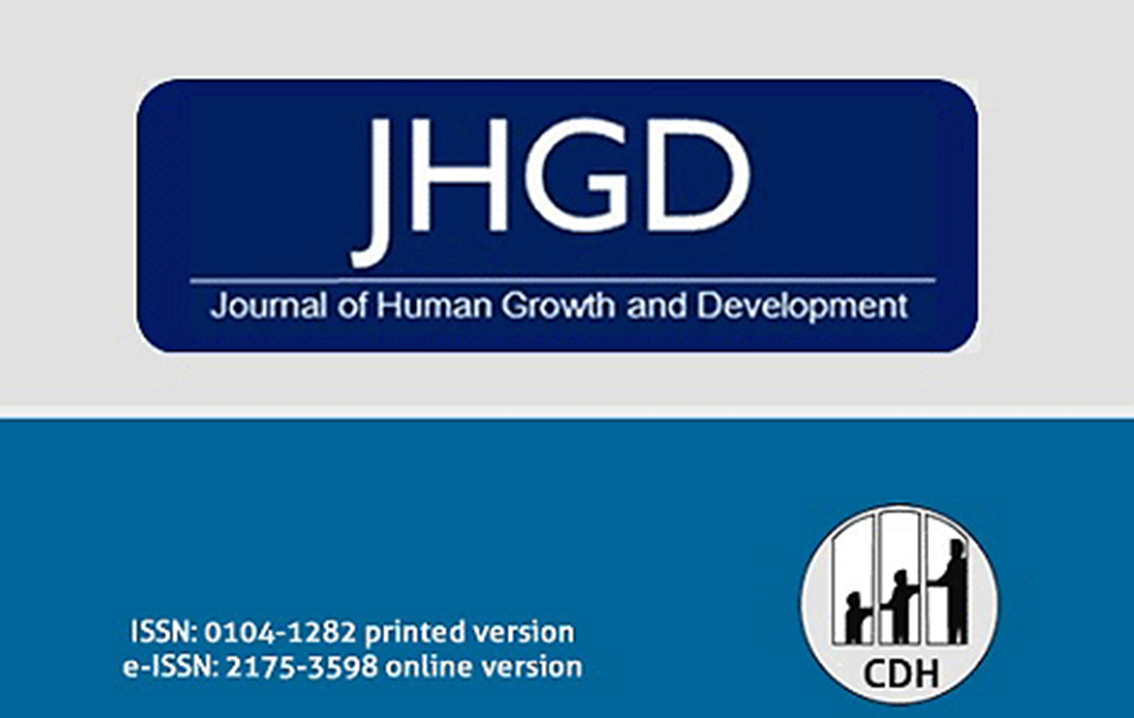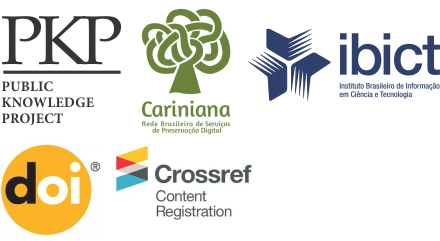Neonatal and temperament variables predict behavior problems of preterm children at toddlerhood
DOI:
https://doi.org/10.7322/jhgd.v29.9527Keywords:
temperament, preterm birth, behavior problems, toddlerhoodAbstract
Background: Children born preterm are at high risk for behavior problems at different ages. To better understand these problems, we examine the predictive biopsychosocial variables.
Objective: To examine the predictive effects of neonatal clinical status and the temperament of the children and mothers on the behavior problems of children born preterm. Study design: Longitudinal predictive study.
Methods: The sample was composed of 40 children born preterm at 18 to 36 months of age and their mothers. The temperament of the children was assessed using the Early Childhood Behavior Questionnaire, which comprises the negative affect, extroversion and effortful control factors and their domains. Behaviors were assessed using the Child Behavior Checklist 1 ½-5 (total, internalized, and externalized problems scores and classifications). The temperament of the mothers was assessed using the Adult Temperament Questionnaire. All instruments were applied through interviews with mothers. Descriptive and the hierarchical multiple linear regression statistical analyses were performed. The level of significance adopted in the study was p < 0.05.
Results: The prediction analysis revealed that the internalized behavior problems were explained significantly by children’s temperaments with more fear (negative affect) and less by mothers’ temperament with inhibitory control (effortful control factor). The externalized behavior problems were explained significantly by greater time spent in the neonatal intensive care unit, less effortful control of children’s temperament and less mothers` temperament inhibitory control.
Conclusion: The behavior problems of children at toddlerhood who were born preterm were explained by high neonatal clinical risk as well as by the temperament dispositional traits of both the children and the mothers.
Downloads
References
2. Arpi E, Ferrari F. Preterm birth and behaviour problems in infants and preschool-age children: a review of the recent literature. Dev Med Child Neurol. 2013;55(9):788-96. DOI: http://dx.doi.org/10.1111/dmcn.12142
3. Scott MN, Taylor HG, Fristad MA, Klein N, Espy KA, Minich N, et al. Behavior disorders in extremely preterm/extremely low birthweight children in kindergarten. J Dev Behav Pediatr. 2012;33(3):202-13. DOI: http://dx.doi.org/10.1097/DBP.0b013e3182475287
4. Groote I, Vanhaesebrouck P, Bruneel E, Dom L, Durein I, Hasaerts D, et al. Outcome at 3 years of age in a population-based cohort of extremely preterm infants. Obstet Gynecol. 2007;110(4):855-64. DOI: http://dx.doi.org/10.1097/01.AOG.0000284447.43442.55
5. Woodward LJ, Moor S, Hood KM, Champion PR, Foster-Cohen S, Inder TE, et al. Very preterm children show impairments across multiple neurodevelopmental domains by age 4 years. Arch Dis Child Fetal Neonatal Ed. 2009;94(5): F339-44. DOI: http://dx.doi.org/10.1136/adc.2008.146282
6. Espírito Santo JL, Portuguez MW, Nunes ML. Cognitive and behavioral status of low birth weight preterm children raised in a developing country at preschool age. J Pediatr. 2009;85(1):35-41. DOI: http://dx.doi.org/10.1590/S0021-75572009000100007
7. Vinall J, Miller SP, Synnes AR, Grunau RE. Parent behaviors moderate the relationship between neonatal pain and internalizing behaviors at 18 months corrected age in children born very prematurely. Pain. 2013;154(9):1831-9. DOI: http://dx.doi.org/10.1016/j.pain.2013.05.050
8. Feldman R. The development of regulatory functions from birth to 5 years: Insights from premature infants. Child Dev. 2009; 80(2):544-61. DOI: http://dx.doi.org/10.1111/j.1467-8624.2009.01278.x
9. Sun J, Mohay HA, O'Callaghan M. A comparison of executive function in very preterm and term infants at 8 months corrected age. Early Hum Dev. 2009;85(4):225-30. DOI: http://dx.doi.org/10.1016/j.earlhumdev.2008.10.005
10. Caravale B, Tozzi C, Albino G, Vicari S. Cognitive development in low risk preterm infants at 3-4 years of life. Arch Dis Child Fetal Neonatal Ed. 2005;90(6):F474-9. DOI: http://dx.doi.org/10.1136/adc.2004.070284
11. Mikkola K, Ritari N, Tommiska V, Salokorpi T, Lehtonen L, Tammela O, et al. Neurodevelopmental outcome at 5 years of age of a national cohort of extremely low birth weight infants who were born in 1996-1997. Pediatrics. 2005;116(6):1391-400. DOI: http://dx.doi.org/10.1542/peds.2005-0171
12. Mikkola K, Kushnerenko E, Partanen E, Serenius-Sirve S, Leipälä J, Huotilainen M, et al. Auditory event-related potentials and cognitive function of preterm children at five years of age. Clin Neurophysiol. 2007;118(7):1494-502. DOI: http://dx.doi.org/10.1016/j.clinph.2007.04.012
13. Fallang B, Oien I, Hellem E, Saugstad Od, Hadders-Algra M. Quality of reaching and postural control in young preterm infants is related to neuromotor outcome at 6 years. Pediatr Res. 2005;5892):347-53. DOI: http://dx.doi.org/10.1203/01.PDR.0000170898.60160.09
14. Jeyaseelan D, O’Callaghan M, Neulinger K, Shum D, Burns Y. The association between early minor motor difficulties in extreme low birth weight infants and school age attentional difficulties. Early Hum Dev. 2006;82(4):249-55. DOI: https://doi.org/10.1016/j.earlhumdev.2005.10.012
15. Bayless S, Stevenson J. Executive functions in school-age children born very prematurely. Early Hum Dev. 2007;83(4):247-54. DOI: https://doi.org/10.1016/j.earlhumdev.2006.05.021
16. Gagne JR, Van Hulle CA, Aksan N, Essex MJ, Goldsmith HH. Deriving childhood temperament measures from emotion-eliciting behavioral episodes: Scale construction and initial validation. Psychol Assess. 2011;23(2):337-53. DOI: https://doi.org/10.1037/a0021746
17. Rueda MR, Rothbart MK. The influence of temperament on the development of coping: the role of maturation and experience. In: Skinner EA, MJ Zimmer-Gembeck MJ. Coping and the development of regulation: new directions for child and adolescent development. San Francisco: Jossey-Bass, 2009; p.19-31.
18. Rothbart MK, Putnam S. Temperament and socialization. In: Pulkinnen L, Caspi A. Paths to successful development: Personality in the life course. Cambridge: Cambridge University Press, 2002; p.19-45.
19. Derauf C, LaGasse L, Smith L, Newman E, Shah R, Arria A, et al. Infant temperament and high risk environment relate to behavior problems and language in toddlers. J Dev Behav Pediatr. 2011;32(2):125-35. DOI: https://doi.org/10.1097/DBP.0b013e31820839d7
20. Eisenberg N, Vaughan J, Hofer C. Temperament, self-regulation, and peer social competence. In: Bukowski WM, Laursen B, Rubin KH. Handbook of peer interactions, relationships, and groups. New York: Guilford Press, 2009; p.473-89.
21. Gracioli SMA, Linhares MB. Temperament related to emotional and behavioral problems in preschool. Psicol Estud. 2014;19(1):71-80. DOI: http://dx.doi.org/10.1590/1413-7372189590007
22. Cosentino-Rocha L, Linhares MBM. Child temperament and gender differences. Paidéia. 2013;23(54):63-72. DOI: http://dx.doi.org/10.1590/1982-43272354201308
23. Stifter CA, Bono MA. The effect of infant colic on maternal self-perceptions and mother-infant attachment. Child Care Health Dev. 1998;2495):339-51. DOI: http://dx.doi.org/10.1046/j.1365-2214.2002.00088.x
24. Piotrowski JT, Lapierre MA, Linebarger DL. Investigating correlates of self-regulation in early childhood with a representative sample of English-Speaking American Families. J Child Fam Stud. 2013;22(3):423-36. DOI: http://dx.doi.org/10.1007/s10826-012-9595-z
25. Hudson JL, Dodd HF, Lyneham HJ, Bovopoulous N. Temperament and family environment in the development of anxiety disorder: Two-year follow-up. J Am Acad Child Adolesc Psychiatry. 2009;50(12):1255-64. DOI: http://dx.doi.org/10.1016/j.jaac.2011.09.009
26. Brophy-Herb HE, Stansbury K, Bocknek E, Horodynski MA. Modeling maternal emotion-related socialization behaviors in a low-income sample: relations with toddlers' self-regulation. Early Child Res Q. 2012;27(3):352-64. DOI: https://doi.org/10.1016/j.ecresq.2011.11.005
27. Putnam SP, Gartstein MA, Rothbart MK. Measurement of fine-grained aspects of toddler temperament: the early childhood behavior questionnaire. Infant Behav Dev. 2006;29(3):386-401. DOI: https://doi.org/10.1016/j.infbeh.2006.01.004
28. Klein VC, Linhares MBM. Temperament, behavior and painful experience in the child development course. Paidéia. 2007;17(36):33-44. DOI: http://dx.doi.org/10.1590/S0103-863X2007000100004
29. Achenbach TM, Rescorla LA. Child Behavior Checklist for Ages 1 ½-5. Burlington: ASEBA, 2000.
30. Evans DE, Rothbart MK. Development of a model for adult temperament. J Res Personality. 2007;41(4):868-88. DOI: https://doi.org/10.1016/j.jrp.2006.11.002
31. Del Ben CM, Zuardi AW. Estudo da confiabilidade do diagnóstico psiquiátrico obtido através da Entrevista Clínica Estruturada para o DSM-III-R (SCID) em um serviço ambulatorial de um Hospital Escola. Dissertação (Mestrado) - Faculdade de Medicina de Ribeirão Preto, Universidade de São Paulo. Ribeirão Preto: 1995.
32. Associação Brasileira das Empresas de Pesquisa (ABEP). Critério de Classificação Brasil. ABEP, 2003.
33. Delobel-Ayoub M, Arnaud C, White-Koning M, Casper C, Pierrat V, Garel M, et al. Behavioral problems and cognitive performance at 5 years of age after very preterm birth: the EPIPAGE study. Pediatrics. 2009;123(6):1485-92. DOI: https://doi.org/10.1542/peds.2008-1216
34. Schiariti V, Hoube JS, Lisonkova S, Klassen AF, Lee SK. Caregiver-reported health outcomes of preschool children born at 28 to 32 weeks’ gestation. J Dev Beh Pediatr. 2007; 28(1):9-15. DOI: https://doi.org/10.1097/01.DBP.0000257516.52459.33
35. Rose SA, Feldman JF, Jankowski JJ. A cognitive approach to the development of early language. Child Dev. 2009;80(1):134-50. DOI: https://doi.org/10.1111/j.1467-8624.2008.01250.x
36. Calkins SD. Regulatory competence and early disruptive behavior problems: the role of physiological regulation. In: Olson SL, Sameroff AJ. Biopsychosocial regulatory processes in the development of childhood behavioral problems. New York: Cambridge University Press, 2009; p.86-115.
37. Betts J, Gullone E, Allen JS. An examination of emotion regulation, temperament and parenting as potential predictors of adolescent depression risk status. Br J Dev Psychol. 2009; 27(Pt 2):473-85. DOI: https://doi.org/10.1348/026151008x314900
38. Maclean PC, Erickson SJ, Lowe JR. Comparing emotional reactivity and regulation in infants born ELGA and VLGA. Infant Beh Dev. 2009;32(3):336-9. DOI: https://doi.org/10.1016/j.infbeh.2009.02.005
39. Laucht M, Esser G, Schmidt MH. Differential development of infants at risk for psychopathology: the moderating role of early maternal responsivity. Dev Med Child Neurol. 2001;45(5):292-300. DOI: https://doi.org/10.1017/s0012162201000561
40. Bridgett DJ, Gartstein MA, Putnam SP, Lance KO, Iddins E, Waits R, et al. Emerging effortful control in toddlerhood: The role of infant orienting/regulation, maternal effortful control, and maternal time spent in caregiving activities. Infant Beh Dev. 2011;34(1):189-99. DOI: https://doi.org/10.1016/j.infbeh.2010.12.008
41. Bates JE, Goodnight JA, Fite JE, Staples AD. Behavior regulation as the product of temperament and environment. In: Olson SL, Sameroff AJ. Biopsychosocial regulatory processes in the development of childhood behavioral problems. New York: Cambridge University Press, 2009; p.116-43.
42. Bradley RH, Corwyn RF. Infant temperament, parenting, and externalizing behavior in first grade: A test of the differential susceptibility hypothesis. J Child Psychol Psychiatry. 2008;49(2): 124-31. DOI: https://doi.org/10.1111/j.1469-7610.2007.01829.x
43. Sclafani JD. The educated parent: recent trends in raising children. Westport: Praeger Publishers, 2004.
44. Schirmer CR, Portuguez MW, Nunes ML. Clinical assessment of language development in children at age 3 years that were born preterm. Arq Neuropsiquiatr. 2006;64(4):926-31. DOI: http://dx.doi.org/10.1590/S0004-282X2006000600007
45. Prior M, Bavinb EL, Cinic E, Reillyc S, Brethertond L, Wake M, et al. Influences on communicative development at 24 months of age: Child temperament, behaviour problems, and maternal factors. Infant Beh Dev. 2008;31(2):270-9. DOI: http://dx.doi.org/10.1016/j.infbeh.2007.11.001
46. Aarnoudse-Moens CS, Weisglas-Kuperus N, van Goudoever JB, Oosterlaan J. Meta-analysis of neurobehavioral outcomes in very preterm and/or very low birth weigth children. Pediatrics. 2009;124(2):717-28. DOI: http://dx.doi.org/10.1542/peds.2008-2816
47. Henderson HA, Fox NA. Considerations in studying emotion in infants and children. In: Coan JA, Allen JJB. The handbook of emotion elicitation and assessment. New York: Oxford University Press, 2007; p.827-64.
48. Cassiano RGM, Linhares MBM. Temperament, prematurity and mother-child interaction behavior. Psicol Reflex Crit. 2015;28(2):416-24. DOI: http://dx.doi.org/10.1590/1678-7153.201528222
49. Barratt MS, Roach MA, Leavitt LA. The impact of low-risk prematurity on maternal behavior and toddler outcomes. Int J Beh Dev. 1996;19(3):581-602. DOI: https://doi.org/10.1177/016502549601900308
50. Gunnar MR. Integrating neuroscience and psychological approaches in the study of early experiences. Ann N Y Acad Sci. 2003;1008:238-47. DOI: https://doi.org/10.1196/annals.1301.024
51. Feldman R, Dollberg D, Nadam R. The expression and regulation of anger in toddlers: Relations to maternal behavior and mental representations. Infant Beh Dev. 2011;34(2):310-20. DOI: https://doi.org/10.1016/j.infbeh.2011.02.001
52. Erickson SJ, Duvall SW, Fuller J, Schrader R, MacLean P, Lowe J.R Differential associations between maternal scaffolding and toddler emotion regulation in toddlers born preterm and full term. Early Hum Dev. 2013;89(9):699-704. DOI: https://doi.org/10.1016/j.earlhumdev.2013.05.003
53. Gartstein MA, Marmion J. Fear and Positive affectivity in infancy: convergence/discrepancy between parent-report and laboratory-based indicators. Infant Behav Dev. 2008;31(2):227-38. DOI: https://doi.org/10.1016/j.infbeh.2007.10.012
54. Morris AS, Morris MDS, Silk JS, Steinberg L, Aucoin KJ, Keyes AW. The influence of mother-child emotion regulation strategies on children’s expression of anger and sadness. Dev Psychol. 2011;47(1):213-25. DOI: https://doi.org/10.1037/a0021021
55. Potharst EV, Schuengel C, Last BF, van Wassenaer AG, Kok JH, Houtzager BA. Difference in mother-child interaction between preterm- and term-born preschoolers with and without disabilities. Acta Pediatr. 2012;101(6):597-603. DOI: https://doi.org/10.1111/j.1651-2227.2012.02599.x|
56. Bernier A, Carlson SM, Whipple N. From external regulation to self-regulation: early parenting precursors of young children’s executive functioning. Child Dev. 2010;81(1): 326-39. DOI: https://doi.org/10.1111/j.1467-8624.2009.01397.x
57. Sameroff AJ. Conceptual issues in studying the development of self-regulation. In: Olson SL, Sameroff AJ. Biopsychosocial regulatory processes in the development of childhood behavioral problems. New York: Cambridge University Press, 2009; p.1-18.







